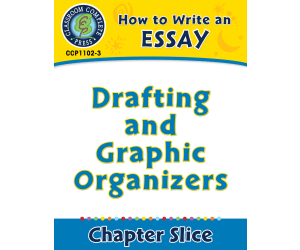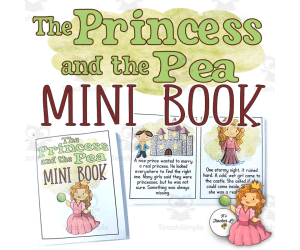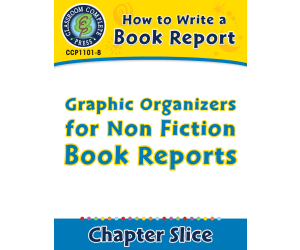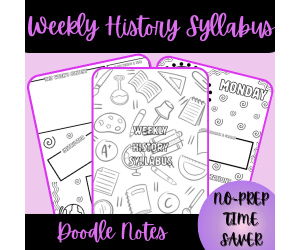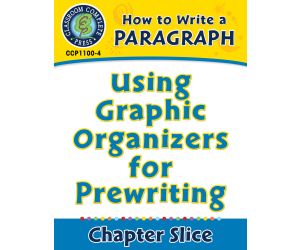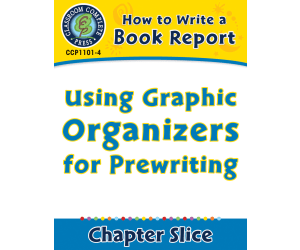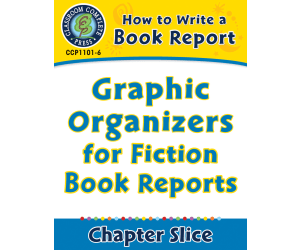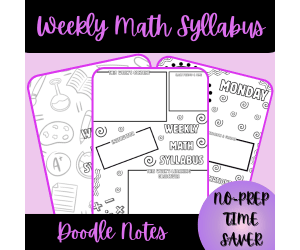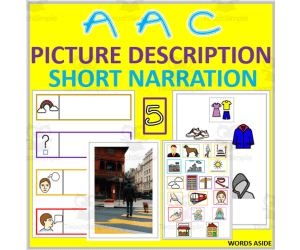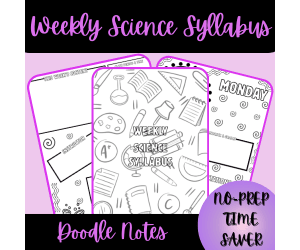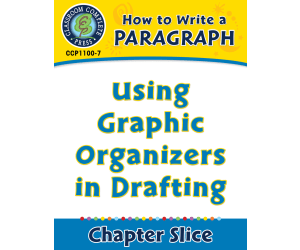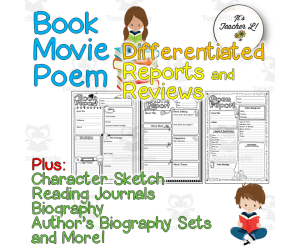2,783 products added recently
Writing Graphic Organizers
Support your students in developing their writing skills by providing graphic organizers that assist with planning and structuring. This collection includes essay outlines, narrative planners, and persuasive writing maps. By integrating these tools, you can help students write more coherently and confidently.
What are Myths, Fables, Legends, and Fairy Tales?
ELA, Literature, Reading, Writing, Grade 3, 4, 5, Drawing Templates & Outlines, Worksheets & Printables, Worksheets, Graphic Organizers, Teacher Tools, Outlines
Brief Activity Overview: In this activity, your child will explore the unique features of myths, fables, legends, and fairy tales . They will watch a short video and use a chart to organize what they’ve learned about each type of story. At the end of this document, be sure to check out the "Beyond the Activity" section for fun extension ideas if your child wants to dive deeper into these story types or try related lessons. Estimated Time: Less than 1 hour Learning Objective: Understand and identify key features of myths, fables, legends, and fairy tales. Subject: English Language Arts Recommended Grade Levels: 3rd – 6th Getting Started: Exploring Story Types Begin by engaging your child in a simple conversation to spark interest and activate prior knowledge: Tell me about one of your favorite storybooks. Suggested discussion questions are included as great way to ease into the lesson and connect your child’s personal reading experiences to the bigger ideas behind storytelling. Introducing the Activity Discuss how many stories fall into categories such as myths, fables, legends, and fairy tales and what your child knows about them (guiding questions are provided). Then, explain that in this activity, they’ll learn more about each type by watching a brief video and taking notes. Encourage them to pay attention to the key features of each story type and notice how they are alike and different . What to Do Next Watch the Video – Invite your child to watch the short video provided. Take Notes – As they watch, encourage them to jot down what they learn about myths, fables, legends, and fairy tales. Discuss and Reflect – After watching, go over the comprehension questions on the next page. These questions can be used: As discussion starters As writing prompts Or a combination of both—whatever works best for your family! 💡 An answer key is included to support your discussion.
Author Sprout & Inspire
Rating
Tags Reading, Myth, Fable, Legend, Fairy Tale, Graphic Organizer, Quick Activity, Ela
How to Write an Essay: Drafting and Graphic Organizers
ELA, Writing, Common Core, Grade 5, 6, 7, 8, Graphic Organizers, Teacher Tools
How to Write an Essay: Drafting and Graphic Organizers - A Valuable Educational Tool This remarkable teaching resource is a highly recommended tool for educators committed to enhancing the writing skills of their students. Contained within are 24 printable pages in PDF format, offering meticulously designed lessons that focus on essay writing suitable for Grade 5 through Grade 8 students. Ease of Learning Moving from drafting, refining language skills, unto effectively applying graphic organizers – it covers everything. Utilizes engaging and interactive methods rather than traditional instruction. Bases its educational foundations on Bloom’s Taxonomy, enabling higher order learning. Rich Content & Versatility Suitable for training in various formats such as narrative essays or persuasive articles along with comprehensive grammar exercises. Serves as standalone material or supplementary resource with inbuilt assessment rubrics & comprehension quizzes tailored perfectly to fetch maximum results. 'How to Write an Essay: Drafting and Graphic Organizers' caters excellently whether implemented in whole class sessions or addressing individual needs, making it an indispensable guide for daily classroom activities or strategic lesson planning. The Added Edge - Graphic Organizers The six colorfully designed graphic organizers not only add vibrancy but serve as crucial roadmaps guiding students towards creating well-structured compositions. Positioned appropriately within the Common Core State Standards framework besides being rooted at varying Bloom's taxonomy levels - this ensures holistic education becomes almost intuitive! Your Ultimate Goal Achieved Easily! If you're an educational professional committed to inspiring your students and fostering creativity and critical thinking skills, this tool would prove invaluable. It succeeds in emboldening young minds to exceed the mediocre, embracing a world of creativity and analytical discourse.
Author Classroom Complete Press
Tags Writing An Essay, Drafts, Graphic Organizer, Writing Process, Language Arts
READING-COMPREHENSION | HUMAN BODY | 20 FREE PAGES
Reading, ELA, Writing, Adult Education, Elementary, High School, Homeschool Resources, Middle School, Not Grade Specific, Anchor Charts, Teacher Tools, Assessments, Quizzes and Tests, Graphic Organizers
READING-COMPREHENSION | HUMAN BODY | 20 FREE PAGES SUMMARY OF THIS PRODUCT: · Document Title: READING-COMPREHENSION | HUMAN BODY · Number of Pages: 20 · File Format (PDF, Word, PPT): PDF · Color or Black & White: COLOR ABOUT THE AUTHOR: At EDITORIAL ARENAS EDUCATIVAS, we believe that learning should be as fun as playing. That’s why we create educational materials that spark children’s curiosity and creativity. I invite you to check out my educational store and discover the wide range of resources that can transform your classes. MAIN INFORMATION OF THIS PRODUCT: What is the name of the product? Hello! Thank you so much for being interested in this beautiful and fabulous product that you can use with your children, both at school and at home. The name of this fabulous product is:READING-COMPREHENSION | HUMAN BODY How many pages does it include? This educational document, carefully created and in some cases compiled, has the following number of pages: 20 What format is it in (A4, letter, digital, printable)? This educational resource is designed in A4 format and PDF, so you will have no difficulties printing it and it will also stay well-protected. A4 PDF Is it in black and white or in color? This document is available in black and white as well as in color. Actually, it combines both, making it more attractive for your students. COLOR SECONDARY AND COMPLEMENTARY INFORMATION: What type of resource is it (activities, guide, set, bundle, workbook)? This resource, like many others, can be an activity or a guide. I also invite you to visit my educational store, where you will find a variety of resources such as games, worksheets, and assessments. For what age, grade, or school level is it ideal? I usually create resources for early grades (children ages 3–5), but I also design for primary students (ages 7–12). My priority is to make children’s learning creative. What learning area does it focus on? This and all my resources focus on children’s essential learning, such as math and literacy. Occasionally, I also create resources for Spanish. What will students learn or practice with it? With this educational resource, children will be able to practice basic skills in math and literacy. Teachers can also adapt it to other learning areas, since learning is multidisciplinary.
Author EDITORIAL LAURA EDUCA
Rating
Tags FREE, FREE RESOURCES, ANCHOR CHART, READING, READING AND COMPREHENSION, COMPREHENSION, HUMAN BODY
The Princess and the Pea Fairy Tale Foldable Mini Book Grade 1 2 3 ELA
ESL, Language Development, ELA, Children’s Literature, Literature, Reading Comprehension, Reading, Handwriting, Writing, Grade 1, 2, 3, Centers, Activities, Crafts, Projects, Assessments, Teacher Tools, Graphic Organizers
Develop the necessary literacy skills of your young learners through this purposefully made The Princess and the PeaMini Book Pack. Created for Grades 1, 2 and 3 students, homeschoolers, and EFL/ESL learners, this resource is designed for reading classes, reading centers, reading comprehension exercises, writing practice, fine motor skills exercises, fairy tale units, supplemental assessment tool, morning work, early finisher additional activities, and so much more! What’s Included: •The Princess and the PeaStory Mini Book– for story retelling, reading and reading comprehension practice •The Princess and the PeaStory Mini BookTrace & Read Pages– handwriting practice and motor skills exercise •The Princess and the PeaMini BookSequencing Booklet– sequencing and sorting exercise, story retelling and reading practice •The Princess and the PeaMini BookRetell & Reflect Pages– retell practice, creativity and imagination development •The Princess and the PeaMini BookBlank Create-a-Story Templates– story telling, supporting creative and imaginative thinking skills •The Princess and the PeaMini BookTeacher Guide + Sample Lesson Plan
Author It's Teacher L
Rating
Tags The Princess And The Pea, Reading Comprehension, ELA Project, Reading Centers
How to Write a Book Report: Graphic Organizers for Non Fiction Book Reports
ELA, Writing, Common Core, Grade 5, 6, 7, 8, Graphic Organizers, Teacher Tools
How to Write a Book Report: Graphic Organizers for Non Fiction Book Reports This teaching resource is an all-in-one solution aimed at engaging both educators and students in the challenging yet exciting endeavor of non-fiction book report writing. Within this comprehensive, 24-page PDF, you'll find all the required tools for helping students in Grades 5 through 8. The Challenge of Teaching Book Reports Writing Tutors may find it daunting to instruct their pupils on how to craft an efficient book report, and such difficulty tends to increase when dealing with non-fiction content. This instructional tool addresses these concerns directly by furnishing step-by-step guidance supplemented with striking graphic organizers. Focusing on Effective Organization and Presentation This resource concentrates on providing learners with concrete methodologies for collating and displaying information about various non-fiction topics encountered during language arts and writing lessons. Teachers can take advantage of these robust tools to facilitate their students' grasp of organized data management during pre-writing stages. Pupil-Efficient Instructions: The teaching aid combats overcomplicated tasks, presenting clear guidance, inclusive of student assessment rubrics and comprehension quizzes promoting seamless understanding among learners. Bloom’s Taxonomy-Based Objectives: Learning goals follow the globally acclaimed Bloom’s Taxonomy framework encouraging advanced cognition as per current educational standards, aligning perfectly with Common Core State Standards. Vocabulary Skill Reinforcement: Ready-to-use word puzzles serve as entertaining interludes while amplifying vocabulary learnt from textbooks, infusing an air of fun into learning activities without compromising educational guidelines. Potential Use Cases across Classroom Activities Educators can choose from multitude options regarding this tool's application. It can be used in numerous techniques ranging from whole-class instructions to small group discussions, outside classroom activities and even individual self-pacing exercises! Concluding Thoughts In essence, tutors seeking engaging methodologies to instruct non-fiction book report writing will find immense value in this aid. The perfect blend of explicit teaching, captivating graphic organizers and extensive student guides makes it a crucial addition to any toolkit. Applying such resource promises simplified yet systematic learning experiences ensuring efficiency at mastering non-fiction book reporting skills.
Author Classroom Complete Press
Tags Language Arts, Writing, Writing A Book Report, Non-fiction Test, Graphic Organizers
Weekly History Syllabus Doodle Notes
Creative Arts, Graphic Arts, ELA, Writing, Resources for Teachers, History, Social Studies, High School, Homeschool Resources, Middle School, Worksheets & Printables, Writing Prompts, Teacher Tools, Graphic Organizers, Outlines, Templates
Ever feel like your history lessons need a serious pick-me-up? After watching my teenager's eyes glaze over during one too many timeline activities, I knew I had to create something different! These Weekly History Syllabus Doodle Notes were born late one night at my kitchen table, surrounded by scattered history books and half-finished lesson plans that weren't working for either of us. As a fellow homeschool mom who's navigated the treacherous waters of teaching history to a teenager (who'd rather be doing ANYTHING else), I have poured all my real-world experience into these templates. Gone are the days of dry, boring history planning that puts both of us to sleep! Instead, I have created visual planning sheets that finally clicked for my visually-oriented teen. Now we're mapping out historical connections, documenting primary source readings, and planning research activities in a way that actually sticks! The magic happens when those historical concepts come alive through both organized planning AND creative visual elements. My daughter went from "Do we have to do history today?" to pointing out connections between historical periods on her own—I amnot kidding! These templates have completely transformed how history works in our homeschool, and I cannot wait for them to do the same for yours. INCLUDED IN THIS RESOURCE: Comprehensive weekly history planning template with visually engaging design Designated spaces for historical learning objectives, content focus, and instructor information Daily sections for documenting classwork, discussions, quizzes, and attendance Specialized reading assignment sections for historical texts and primary sources Homework planning areas with website research recommendations and writing prompts Visual note-taking spaces that connect historical concepts with creative representation Structured organization that accommodates the unique narrative nature of history instruction Look, I am not going to pretend I'm some super-organized homeschool mom with color-coded bookshelves (my laundry pile would quickly disprove that myth!). But after years of history lessons that felt like pulling teeth, these doodle notes have honestly saved our homeschool history curriculum. Sunday afternoons used to find me stressed and overwhelmed, staring at history books and wondering how to make centuries-old events relevant to my tech-obsessed teen. Now? I actually look forward to mapping out our history week! The combination of chronological organization with visual creativity means concepts stick in a way they never did before. My daughter has gone from glazed-over eyes to making connections between historical periods on her own. No joke—last week she compared political patterns from ancient Rome to something in today's news WITHOUT PROMPTING! Grab these templates today, and in a few weeks, you will be texting your homeschool friends about how your kid suddenly loves history. (And they'll demand to know your secret!) If you and your students/homeschoolers enjoyed this resources, please leave a review. Thank you for your support! Tina - Big Easy Homeschooling Mom Please subscribe: tidewindacademyhomeschool.com
Author Homeschool with Big Easy Homeschooling Mom
Rating
Tags History Doodle Notes, Visual Aids, Visual Learning Tools, Social Studies Planning, History Syllabus Templates, Doodle Notes, Homeschool History Organization, Homeschool Social Studies Organization Tools, Weekly History Planning Templates For Homeschoolers, Educational Organization
CHARACTER: The FIVE Elements of a Story Graphic Organizers
ELA, Reading, Reading Comprehension, Language Development, Pre-Reading, Writing, Not Grade Specific, Teacher Tools, Graphic Organizers
This is our CHARACTER section of our Graphic Organizers Series: The FIVE Elements of a Story. In this set, you can enjoy 10 custom graphic organizers for Character. These graphic organizers can be used in any classroom, for any grade, and with any student. Included in this set are: - Character Map - Character Trait Chart - Character Feelings - Relationship Web - Character Comparison - Character Scrapbook - Character Analysis - Character Development - Character Cluster - Character Sketch Use these graphic organizers to help students gain an understanding of Character in a story. Each graphic organizer comes with instructions on how to use them. Character Graphic Organizers: Character Map - Write the name of the character in the middle circle. Then, describe the character’s actions in the top left square; what the character says and how they speak in the top right square; the character’s feelings in the bottom left square; and what the character looks like in the bottom right square. Character Trait Chart - Choose a character from the story. In the first column, write down any traits that your character has. Include physical features, personality, feelings, and anything else that describes your character. In the second column, provide evidence from the story to support your chosen trait. Character Feelings - In the top box, describe the character’s feelings at the beginning of the story. In the next series of boxes, describe an event that has an effect on the character, then how this character feels as a result of this event. In the last box, describe the character’s feelings at the end of the story. Relationship Web - Write the name of the main character in the story in the middle circle. In the circles branching out from the middle one, write down the relationships the character has. Include whether you think this is a good relationship or a bad one. Do the same for any other character in the story. Character Comparison - Use the Venn Diagram to compare two characters from the story. Write the names of each character in the overlapping circles. Write any differences the characters have with one another in the outside circles. Write any similarities the characters have in the middle of both circles. Character Scrapbook - Create a scrapbook for one of the characters in the story. Choose a character from the story. Choose some important events that happen in the story that shapes the character. Draw pictures of these events and explain what happened and how it affected the character. Character Analysis - Keep track of every character in the story and their traits. Write the name of each character in the story in the first column. Write a trait that the character has in the second column. In the third column, write down the page and paragraph number of a quote that proves this trait. Character Development - Choose a character from the story. Write down their initial thought on a topic or situation in the first column. In the second column, write down the event that has an effect on that character’s thoughts. Then, write down the character’s new thoughts on the topic or situation in the third column. Character Cluster - is Cluster Map can be completed in many different ways. Start with a character in the middle triangle. Then, branch out from the character with related topics in the circles. Expand on those topics in the rectangles. Suggestions include: relationship web, traits web, feelings web. Character Sketch - Complete this Character Sketch of any character in the story by writing what the character says, thinks, hates, loves, owns, does or uses. Also include the characters strengths and weaknesses, and where the character has come from in the story, and where the character is going.
Author Ibby Resources
Rating
Tags Study, Skills, Character, Literary, Device
Weekly ELA Syllabus Doodle Notes
ELA, Writing, Resources for Teachers, High School, Homeschool Resources, Middle School, Worksheets & Printables, Writing Prompts, Teacher Tools, Graphic Organizers, Outlines, Templates
Imagine jazzing up your language arts planning with these Weekly ELA Syllabus Doodle Notes . They are not just templates; they are a fun way for teachers and students alike (including homeschoolers!) to dive into learning. Think of them as beautifully designed organizers that blend pictures with practical planning. T his combo makes mapping out your ELA curriculum not only work better but also feel more enjoyable. Each page gives you neat spots to jot down what you're doing each day, assignments, what you're reading, and writing ideas – all sprinkled with cool visuals that help things stick and get those creative juices flowing. INCLUDED IN THIS RESOURCE: ✔Comprehensive weekly ELA planning template with visually engaging design ✔Designated spaces for ELA learning objectives, content focus, and instructor information ✔Daily sections for documenting classwork, discussions, quizzes, and attendance ✔Specialized reading assignment sections for texts and primary sources ✔Homework planning areas with website research recommendations and writing prompts ✔Visual note-taking spaces that connect concepts with creative representation ✔Structured organization that accommodates the unique narrative nature of ELA instruction I've poured a lot of thought into these templates, and my hope is that they will become your go-to for language arts planning – the kind of tool that makes sure you don't miss a thing and actually makes the process a little bit of fun! You will probably find that the straightforward design helps you set clear expectations for your students (or homeschoolers), and they, in turn, will dig the visual bits that make lessons more interesting and easier to remember. Seriously, everything you need for a full ELA experience fits nicely into one good-looking and useful resource. Whether you're a seasoned homeschooling pro or just starting out as a teacher, I think you will find these templates hit that sweet spot of being organized without cramping your style. Let's shake up your language arts planning with my Weekly ELA Syllabus Doodle Notes ! I have mixed practical organization with visual learning tricks that really do the job – helping you make plans that keep everyone focused, boost memory, and get your students (or homeschoolers) more involved. Y ou might even find yourself looking forward to planning, which is saying something! Your students/homeschoolers will appreciate knowing what's coming each week, and you will love having all your ideas in one place with a bit of creative flair. Go ahead and treat yourself to this planning upgrade and see how it can bring a fresh vibe to your language arts teaching – getting organized has never felt so good! If you and your students/homeschoolers enjoyed this resource, please leave a review. Thank you for your support! Tina - Big Easy Homeschooling Mom
Author Homeschool with Big Easy Homeschooling Mom
Rating
Tags ELA Doodle Notes, ELA Organization, Visual Aids, Visual Learning Tools, Syllabus Templates, Creative Teaching Tools, Doodle Notes, ELA Planning, Weekly Planning Template, ELA Weekly Planning
How to Write a Paragraph: Using Graphic Organizers for Prewriting
ELA, Writing, Common Core, Grade 5, 6, 7, 8, Graphic Organizers, Teacher Tools
How to Write a Paragraph: Using Graphic Organizers for Prewriting This is an essential educational resource to enhance students' writing proficiency. In this chapter, the focus is on the use of graphic organizers for prewriting, with a step-by-step guide aimed at simplifying the writing process and enhancing language arts skills. Homeschool educators and public school teachers alike will find great value in using this tool. It serves as an excellent supplement to existing reading programs and even stands well as independent student work - making it beneficial whether used with a whole class, small groups or given as homework assignments. This resource encourages thought articulation through well-crafted sentences and paragraphs – something crucially significant for students in Grades 5 through 8. The four main types of paragraph forms introduced through this lesson plan are based on Bloom’s Taxonomy learning objectives. Makes writing logical yet easy-to-understand Offers multiple opportunities for maximized efficiency during the prewriting phase using various graphic organizers Six color graphic organizers are included that not only define skill focus but assist learners navigate their way meticulously through words Detailed Implementation Guide & Additional Extras: A comprehensive implementation guide, in PDF form, is provided within this product file offering tips on incorporating it effectively into your teaching cycle – so you can invest more time in instructing rather than planning! Plus word puzzles elevate the fun element in education alongside a comprehension quiz meant at subtly but accurately assessing understanding level. Assessment Rubric: An assessment rubric tailored considering student performances assists objective grading while remarkably meeting Common Core State Standards as well aligning perfectly with Bloom's Taxonomy. Cements learning outcomes making this product How to Write a Paragraph: Using Graphic Organizers for Prewriting a sought-after asset in pedagogy.
Author Classroom Complete Press
Tags PDF
SUPER PACK | 10 FREE READINGS | TEXT+QUESTIONS+ANCHOR CHARTS
Reading, ELA, Writing, Adult Education, Elementary, High School, Homeschool Resources, Middle School, Not Grade Specific, Early Learning, Anchor Charts, Teacher Tools, Assessments, Charts, Graphic Organizers, Quizzes and Tests, Workbooks, Worksheets & Printables
SUPER PACK | 10 FREE READINGS | TEXT+QUESTIONS+ANCHOR CHARTS ABOUT THE AUTHOR: At EDITORIAL ARENAS EDUCATIVAS, we believe that learning should be as fun as playing. That’s why we create educational materials that spark children’s curiosity and creativity. I invite you to check out my educational store and discover the wide range of resources that can transform your classes. MAIN DESCRIPTION: What is the name of the product? Hello! Thank you so much for being interested in this beautiful and fabulous product that you can use with your children, both at school and at home. The name of this fabulous product is: SUPER PACK | 10 FREE READINGS How many pages does it include? This educational document, carefully created and in some cases compiled, has the following number of pages: 200 What format is it in (A4, letter, digital, printable)? This educational resource is designed in A4 format and PDF, so you will have no difficulties printing it and it will also stay well-protected. PDF A4 SUMMARY OF THIS PACK: What is the name of the document?: SUPER PACK | 10 FREE READINGS How many pages does it include?: 20 In what format is it available (PDF, Word, PPT)?: PDF Is it in color or black and white?: COLOR EXTRA INFORMATION: What type of resource is it (activities, guide, set, bundle, workbook)? This resource, like many others, can be an activity or a guide. I also invite you to visit my educational store, where you will find a variety of resources such as games, worksheets, and assessments. For what age, grade, or school level is it ideal? I usually create resources for early grades (children ages 3–5), but I also design for primary students (ages 7–12). My priority is to make children’s learning creative. What learning area does it focus on? This and all my resources focus on children’s essential learning, such as math and literacy. Occasionally, I also create resources for Spanish. What will students learn or practice with it? With this educational resource, children will be able to practice basic skills in math and literacy. Teachers can also adapt it to other learning areas, since learning is multidisciplinary.
Author EDITORIAL LAURA EDUCA
Rating
Tags FREE, FREE RESOURCES, PACK, SUPER PACK, BUNDLE, READINGS, TEXT, ELA, READING, READING AND COMPREHENSION
How to Write a Book Report: Using Graphic Organizers for Prewriting
ELA, Writing, Common Core, Grade 5, 6, 7, 8, Graphic Organizers, Teacher Tools
How to Write a Book Report: Using Graphic Organizers for Prewriting This resource is designed to aid in the education of students, focusing on the organization of thoughts and ideas before they begin writing book reports. Ideal for students between grade 5 and 8, this resource falls squarely within the Language Arts category with an emphasis on enhancing writing skills. The primary function of this tool is to revolutionize the often daunting task of book report assignments by using easily accessible graphic organizers during prewriting. These handy devices guide students through organizing their thoughts concerning key elements such as plot structure, character characteristics, and themes which are essential in creating engaging book reports. A well-organized outline aligns with Bloom's Taxonomy learning objectives; this resource encourages a progressive learning method gliding students gradually from understanding facts through synthesis and evaluation stages - guiding each step along the way to completing polished reports that strictly adhere to proper forms and mechanics. Besides being just a teaching tool, educators can use this resource creatively - whether as supplementary material complementing an ongoing writing program or self-sufficient activities assigned at home. The inclusive package doesn't only include exciting word puzzles enhancing language skills but also comprehension quizzes significantly instrumental in determining student's grasp level over learned concepts. To ensure flawless execution of preset activities included in lesson plans, there’s added reassurance with inclusion of detailed guides breaking down how tasks should be approached. An additional feature includes easy-to-use student assessment rubrics simplifying grading process while ensuring fair basis during marking exercise - offering overall a systemically designed educational experience bundling together both learning and assessment processes neatly organized within one place. Kept flexible via maintaining it available on PDF; it enables usage electronically during virtual classes or printed paper copies accommodating varied class systems from whole group teaching to small group combined studies. This promising writing developmental course for intermediate level students, adheres strictly to the Common Core State Standards and is thoughtfully curated implementing Bloom's Taxonomy techniques forming its fundamental foundation.
Author Classroom Complete Press
Tags PDF
FREE: The FIVE Elements of a Story Graphic Organizers
ELA, Reading, Reading Comprehension, Language Development, Pre-Reading, Writing, Not Grade Specific, Teacher Tools, Graphic Organizers
This is a FREE sample of our Graphic Organizers Series: The FIVE Elements of a Story. In this sample, you can enjoy a selection of 10 custom graphic organizers for Character, Setting, Plot, Theme, and Conflict. These graphic organizers can be used in any classroom, for any grade, and with any student. Use these graphic organizers to help students gain an understanding of the five elements of a story. Each graphic organizer comes with instructions on how to use them. Character Graphic Organizers: Character Map - Write the name of the character in the middle circle. Then, describe the character’s actions in the top left square; what the character says and how they speak in the top right square; the character’s feelings in the bottom left square; and what the character looks like in the bottom right square. Character Comparison - Use the Venn Diagram to compare two characters from the story. Write the names of each character in the overlapping circles. Write any differences the characters have with one another in the outside circles. Write any similarities the characters have in the middle of both circles. Setting Graphic Organizers: Setting Stage - Draw the setting that the story takes place in on the stage in this graphic organizer. Be sure to illustrate the time and place that the story takes place in. Also include the environment of the story, and try to show the tone or mood that the setting creates for the story. Elements of Setting - Place + Time + Environment + Mood = Setting in this Graphic Organizer. Describe the Place that the story takes place in the top left box. Then, describe the Time in the top right box. Then, describe the Environment in the bottom left box. Finally, describe the Mood in the bottom right box. Plot Graphic Organizers: Plot Pyramid – Complete this classic Plot Pyramid graphic organizer by writing the Introduction of the story in the bottom left box. Then, describe the Rising Action, followed by the Climax of the story. Finish up with the Falling Action and the Resolution or Conclusion of the story. Storyboard – Illustrate the plot or an event from the story. Draw or describe in detail each stage in the plot or in an event that takes place in the story. Remember, the order of plot development is: Introduction, Rising Action, Climax, Falling Action, and Resolution/Conclusion. Theme Graphic Organizers: Theme Chart – First identify the main characters, main conflict, and theme of the story. Then, breakdown the theme of the story by first writing down the beginning of the theme. Follow this by writing the development of the theme, then the climax of the theme. Finish off with the resolution of the theme. Theme Identifier – Get help identifying the Theme of a story by answering the questions. Start off by describing what happens in the story. Then, identify the most important event in the story. Explore the characters by identifying how they change and what they learn. Finally, determine what the author is trying to tell you. Conflict Graphic Organizers: Conflict Dissection – Complete this graphic organizer by filling in each quadrant. In the first box, identify the characters of the story. In the next box, identify the time and place of the story. In the third box, identify the problem that takes place in the story. In the last box, identify the solution to the problem. Conflict Type Chart – In the first column, find examples from the story that shows Character against Character. In the second column, find examples of Character against Nature. In the third column, find examples of Character against Self. And finally, in the fourth column, find examples of Character against Society.
Author Ibby Resources
Tags Study, Skills, Character, Setting, Plot, Theme, Conflict, Literary, Device
How to Write a Book Report: Graphic Organizers for Fiction Book Reports
ELA, Writing, Common Core, Grade 5, 6, 7, 8, Graphic Organizers, Teacher Tools
**This is the chapter slice "Graphic Organizers for Fiction Book Reports" from the full lesson plan "How to Write a Book Report"** Do your students groan in despair when book reports are assigned? Our workbook provides opportunities for students to use graphic organizers during the prewriting process and offers clear and concise instruction in the drafting and revision phases. The learning objectives contained are based on Bloom’s Taxonomy and provide instruction in the correct form and mechanics of all book reports. You can use this material to supplement your present writing program or for independent student work. Also included is a detailed implementation guide, student assessment rubric, word puzzles and comprehension quiz. The six color graphic organizers will assist the introduction of the skill focus and in guiding your students through their successful writing process. All of our content meets the Common Core State Standards and are written to Bloom's Taxonomy.
Author Classroom Complete Press
Tags Language Arts, Writing, Book Report, Graphic Organizers, Fiction Text, Written Book Reports By Students
Weekly Math Syllabus Doodle Notes
Creative Arts, Graphic Arts, ELA, Writing, Resources for Teachers, High School, Homeschool Resources, Middle School, Teacher Tools, Graphic Organizers, Outlines, Templates, Worksheets & Printables, Writing Prompts
Transform your mathematics teaching with these dynamic Weekly Math Syllabus Doodle Notes . As a homeschool mom to a creative teenager, I thoughtfully crafted these to make math planning more organized, effective, and visually engaging. These innovative planning templates bridge the gap between logical mathematical thinking and creative visual organization, providing a comprehensive system for documenting and planning your students'/homeschoolers' weekly math curriculum. The unique doodle note format combines structured planning spaces with visual elements that enhance information retention and make the planning process enjoyable for educators while creating clear expectations for students/homeschoolers. INCLUDED IN THIS RESOURCE: Comprehensive weekly math planning template with visually engaging design Designated spaces for learning objectives, content focus, and instructor information Daily sections for documenting classwork, quizzes, tests, and attendance Specialized "Topics to Cover" sections specifically designed for math curriculum Homework planning areas with assignment tracking and website research spaces Visual note-taking spaces that encourage creative organization of mathematical concepts Writing prompt sections to encourage mathematical reasoning and explanation. Give a boost to your mathematics instruction with these Weekly Math Syllabus Doodle Notes , combining logical organization with visual creativity for a more effective teaching experience. These thoughtfully designed templates transform the potentially overwhelming task of mathematics curriculum planning into an organized, engaging process that benefits both educators and students/homeschoolers. Doodle notes are proven to enhance engage and creativity for any subject! If you and your students/homeschoolers enjoyed this resource, please leave a review. Tina - Big Easy Homeschooling Mom
Author Homeschool with Big Easy Homeschooling Mom
Rating
Tags Visual Aids, Visual Learning Tools, Math Planning, Visual Math Teaching , Math Syllabus, Math Doodle Notes, Math Curriculum Organizer, Weekly Planning Templates, Math Resources, Creative Math Resources
AAC | Picture Description Short Story | Visual Guide Resource 5
Special Resources, ELA, Special Education Needs (SEN), Speech Therapy, Language Development, Pre-Reading, Vocabulary, Writing, Kindergarten, Preschool, Grade 1, 2, Teacher Tools, Graphic Organizers
AAC Picture Description Short Story Visual Guide Resource 5 is an educational resource designed specifically for educators and therapists. Its main goal is improving the language development, communication, and early literacy skills of children with special education needs (SEN), speech therapy patients, as well as mainstream classroom students primarily from preschool through grade two. This resource combines various teaching aids including: Real-life pictures Color-coded sentence strips Familiar themes like WHO / WHAT DOING / WHERE / WHEN / WEATHER / SURROUNDINGS/ THOUGHTS represented on separate pages Description of clothes or individual's appearance etc. The learning journey begins with a real-life photo that serves as the basis for all ensuing activities then leverages color-coded sentence strips to help children formulate narratives around familiar themes. Additional features include descriptions of clothing worn by individuals in photos and sequential answer boards that allow narrative formation through randomized questioning. An added attribute of this resource pack is the inclusion of blank colour coded pages which invite learners to contribute creatively- customizing stories in their unique way thus strengthening their communication roots further. The AAC Picture Description Short Story Visual Guide Resource 5 offers immense flexibility - use it en masse during whole-group instruction sessions or divide it among smaller groups; distribute it for homework assignments enhancing independent thinking; make use of task cards material available within; or even creating minibooks complete with descriptive strips and boards! This package comprises 16 printable PDFs each equipped with: Sentence construction strips Narration boards & Answer cards aiming at improving children's verbal abilities+ Note: The downloaded file can be printed and laminated for use. While this tool is designed primarily for use in educational environments, it can be equally beneficial during one-on-one learning or therapy sessions at home facilitated by parents/guardians and is thus an excellent asset towards children's verbal, cognitive, social and emotional development.
Author WORDS ASIDE
Tags AAC, Picture Description, Short Story, Visual Guide, Communication Skills
Weekly Science Syllabus Doodle Notes
ELA, Writing, Graphic Arts, Creative Arts, Science, High School, Homeschool Resources, Middle School, Worksheets & Printables, Writing Prompts, Teacher Tools, Graphic Organizers, Templates, Outlines
Are you ready to breathe new life into your science lessons? T hese Weekly Science Syllabus Doodle Notes were born out of my own frustration as a homeschool mom trying to juggle curriculum planning while keeping my kids actually interested in science. Trust me, I have spent countless late nights staring at bland planning sheets thinking, "There has to be a better way!" After one too many uninspiring science lessons, I created these templates that have completely transformed how we approach science in our homeschool. These are not just another pretty printable—they are the answer to that moment when you realize your kiddo has retained exactly zero information from last week's lesson on photosynthesis! I have designed them to be your visual playground, where mapping out experiments and research activities becomes something you and your students/homeschoolers actually look forward to. My own teenage daughter went from groaning about science to pointing at their doodle notes saying, "Remember when we did that cool experiment?" The secret sauce? These notes engage both the logical and creative sides of your brain, which means those scientific concepts finally stick—no more blank stares when you ask, "Remember what we learned last Tuesday?" These have been a game-changer in our homeschool, and I can't wait for them to transform yours too! INCLUDED IN THIS RESOURCE: ✔Comprehensive weekly science planning template with visually engaging design ✔Designated spaces for scientific learning objectives, content focus, and instructor information ✔Daily sections for documenting science classwork, lab activities, quizzes, and attendance ✔Specialized reading assignment sections for scientific texts and research articles ✔Homework planning areas with website research recommendations and writing prompts ✔Visual note-taking spaces that connect scientific concepts with creative representation ✔Structured organization that accommodates the unique needs of science instruction Sunday nights used to be my nightmare—frantically scrambling to plan science lessons while dreading the glazed-over looks I would get from my teenager the next day. Sound familiar? Those days are OVER! With these Weekly Science Syllabus Doodle Notes , I have actually caught myself looking forward to planning time (weird, right?). Let me tell you, juggling high school science with a creative teen who'd rather be doing anything else pushed me to my breaking point. My kitchen table was buried under boring worksheets that neither of us was excited about. That is when I decided to create these templates—not because I am some super-organized homeschool mom (ha!), but because I desperately needed something that would work for both my planning sanity AND my visually-oriented teenager. The magic happens when organization meets creativity! Now my daughter can actually see what is coming each week, and those complex scientific concepts finally stick because the visual elements speak her language. I still cannot believe how much easier our science days flow now! Seriously, grab these today—your future bleary-eyed, lesson-planning self will high-five you when you realize science class has transformed from a battle to the highlight of your homeschool week! If you and your students/homeschoolers enjoyed this resource, please leave a review. Thank you for your support! Tina - Big Easy Homeschooling Mom Website: tidewindacademyhomeschool.com
Author Homeschool with Big Easy Homeschooling Mom
Rating
Tags Visual Aids, Visual Learning Tools, Weekly Planning Template, Science Planning, Science Syllabus, Creative Syllabus Templates For Science Students/homeschoolers, Science Curriculum Organizer, Creative Teaching Tools, Homeschool Science Organization, Homeschool Planning
Graphic Organizers Simplified B - Reading, Writing & Thinking Skills
ELA, Reading, Writing, Grade 3, 4, Graphic Organizers, Teacher Tools
This graphic organizer -based resource is designed for grades 3 to 4. The graphic organizers included in this resource helps students organize their thoughts to be successful in reading, writing and thinking. Graphic organizers are used to help students become better readers, writers and thinkers. This is the first book in a series of four that provides ready-to-use content. The lessons within this resource are made up of three sections: a reading section, a graphic organizer , and comprehension-style worksheets. Aligned to the International Reading Association and National Council of Teachers of English Standards 1, 3, 6, and 12.
Author Classroom Complete Press
Tags Graphic Organizers, Comprehension, Answers, Primary, Elementary
How to Write a Paragraph: Using Graphic Organizers for Drafting
ELA, Writing, Grade 5, 6, 7, 8, Graphic Organizers, Teacher Tools
How to Write a Paragraph: Using Graphic Organizers for Drafting An invaluable resource for mastering the art of paragraph writing, carefully crafted to equip learners with the fundamental skills needed to express their thoughts coherently in well-scripted sentences and paragraphs. About the Workbook This comprehensive workbook provides diverse opportunities for students across grades 5 to 8. It supports them as they navigate through prewriting stages using multi-faceted graphic organizers. It revolves around four primary types of paragraph forms, encouraging students to constructively manage their ideas, ensuring an effective drafting structure. Learning Incorporation & Versatility The guidelines provided align flawlessly with Bloom’s Taxonomy aiming at building higher-order thinking skills which are essential in today's education environment. This versatile resource can be incorporated into existing reading programs or used as self-guided student work. Its subject matter focuses on language arts and writing - however, the lessons learnt can easily be transposed across many other subjects. Inclusivity & Engagement Inclusivity plays a significant role; therefore it comes with six bright engaging graphic organizers aimed at simplifying complex concepts while grabbing attention making learning fun yet impactful. The product also includes additional perks such as an implementation guide offering tips and tricks on how best educators can employ this resource in different settings like whole group instruction, small study group activities or even homework assignments leading towards improvement. It also carry a student assessment rubic along with word puzzles for vocabulary enhancement and comprehension quizzes providing ample opportunity for reinforcement and evaluation purposes. Note: This extensive lesson plan comes saved as a PDF file ensuring compatibility across various platforms without compromising layout integrity or losing content quality. Recognize your student’s potential by introducing them to How to Write a Paragraph: Using Graphic Organizers for Drafting - A simplistic tool designed purely on successful teaching fundamentals making writing less daunting and a lot more enjoyable.
Author Classroom Complete Press
Tags PDF
Graphic Organizers Simplified A - Reading, Writing & Thinking Skills
ELA, Reading, Writing, Grade 2, 3, Graphic Organizers, Teacher Tools
This graphic organizer -based resource is designed for grades 2 to 3. The graphic organizers included in this resource helps students organize their thoughts to be successful in reading, writing and thinking. Graphic organizers are used to help students become better readers, writers and thinkers. This is the first book in a series of four that provides ready-to-use content. The lessons within this resource are made up of three sections: a reading section, a graphic organizer , and comprehension-style worksheets. Aligned to the International Reading Association and National Council of Teachers of English Standards 1, 3, 6, and 12.
Author Classroom Complete Press
Tags Graphic Organizers, Comprehension, Answers, Primary, Elementary
Book, Movie, Poem Differentiated Reports, Reviews AND MORE!
ELA, Strategies, Language Development, Vocabulary, Writing, Grade 4, 5, 6, Teacher Tools, Graphic Organizers, Activities, Worksheets & Printables, Worksheets
This Book, Movie, Poem Differentiated Reports and Reviews is a set of 23 pages graphic organizers no-prep worksheets that are designed for primary level learners, ESL/EFL students and homeschoolers. The worksheets are made to accompany reading and writing activities that will help learners better understand the contents of their class lessons. Aside from the worksheets that can help students record and report about the books, movies, and poems that they are learning, this resource also includes reading journals, character sketch, biography, author’s biography, and vocabulary log worksheets, as well as book reading and movie tracker worksheets. The graphic organizers are amazing tools to use, guide and gauge the students’ grasp of the lessons and help the learners take control of their own learning. Additionally, this set includes differentiated activities to cater to different level of learners. Contents: Movie Reports Movie Reviews Movie Tracker Book Reports Book Reviews Book Reading Tracker Poem Reports Poem Reviews Reading Journals Character Sketch Worksheets Biography Worksheets Author’s Biography Worksheets Vocabulary Log Worksheets Applications: 1. Supplemental tools for book reading, movie analysis, and poem study lessons. 2. Can be used as assessment tools, homework and projects. 3. Perfect inclusion to students’ portfolios. 4. Research practice activities. 5. Teacher-emergency tool.
Author It's Teacher L
Tags Book Review, Book Report, Movie Review, Movie Report, Poem Review, Poem Report, Biography, Authors Biography, Vocabulary Log
PLOT: The FIVE Elements of a Story Graphic Organizers
ELA, Reading, Reading Comprehension, Language Development, Pre-Reading, Writing, Not Grade Specific, Teacher Tools, Graphic Organizers
This is our PLOT section of our Graphic Organizers Series: The FIVE Elements of a Story. In this set, you can enjoy 10 custom graphic organizers for Plot. These graphic organizers can be used in any classroom, for any grade, and with any student. Use these graphic organizers to help students gain an understanding of Plot in a story. Each graphic organizer comes with instructions on how to use them. Plot Graphic Organizers: Plot Pyramid – Complete this classic Plot Pyramid graphic organizer by writing the Introduction of the story in the bottom left box. Then, describe the Rising Action, followed by the Climax of the story. Finish up with the Falling Action and the Resolution or Conclusion of the story. Sequence – Describe events from the story in sequence. Start off by writing the Initiating Event, or the event that starts off a chain reaction, in the top box. Follow this with the Steps that directly result from this event in order that they occur. Finish up by writing the Final Outcome of this event. Prediction Chart – In the first column, write down what you predicted, or thought would happen in the story. In the second column, write down what actually happened in the story. Continue this format for each event you predict will happen in the story. Storyboard – Illustrate the plot or an event from the story. Draw or describe in detail each stage in the plot or in an event that takes place in the story. Remember, the order of plot development is: Introduction, Rising Action, Climax, Falling Action, and Resolution/Conclusion. Story Structure – Complete the Story Structure by identifying the Introduction, events of the Rising Action, Climax, events of the Falling Action, and the Conflict and Resolution of the story. Then, identify the theme of the story, as well as the setting of the story (where and when the story takes place). Sequence Chain – Describe up to 9 events from the story in the order that they occur. Write the first event in the first box, followed by the second event in the following box, and so on following the chain. It is not necessary to fill in every box with an event. For an extra activity, draw each event in detail. Prediction Tree – In this Prediction Tree graphic organizer, write your question at the base of your tree. On the trunk, write down your prediction to the answer of the question posed. On the branches, write down evidence from the story to support your prediction. Story Cycle – Describe the Introduction of the story in the top right box. Following the cycle, describe the Rising Action next. Then, include the Climax of the story. Follow this with the Falling Action, and finally with the Resolution of the story. Then, describe how the Resolution relates back to the Introduction. Changes in Plot – Identify how the Plot changes throughout the story. In the first column, write down what happened in the beginning of the story. In the second column, write down what happened at the end of the story. Compare the two to show how the plot changed. Do this for every event in the story. Plot Analysis – Describe the Introduction and identify the Point of View. Describe the Rising Action and what’s being Forshadowed if relevant. Identify the Inciting Force and the Climax. Describe the Falling Action and any Suspense that is experienced. Describe the Conclusion and any Symbolism that is present.
Author Ibby Resources
Rating
Tags Study, Skills, Character, Literary, Device
Pack of Student Planner and Tracker
Special Resources, Life Studies, ELA, Life Skills, Writing, Grade 4, 5, 6, Teacher Tools, Graphic Organizers, Activities, Worksheets & Printables, Worksheets
This 20-pages Student Planner and Tracker Pack includes Assignment Trackers, Examination Trackers, Group Project Trackers, Individual Project Trackers, Daily Dumps (Daily Planners), and Weekly Grinds (Weekly Planners). The designs and organization of the planners in this pack are specifically made to be easy-to-use and engaging so that students will enjoy monitoringand learning to focus on their important tasks. Some planners and trackers have areas where teachers and parents can write their notes and signatures making them teacher and parent friendly especially in checking the learners' school or daily progress. The different designs are aimed to give teachers and parents freedom to choose the best style they need for their classes. This no-prep worksheet planner packs are non-editable and can be part of the students' folder files or take home folders. What’s included: 1. 6 Assignment Trackers: convenient way to keep track of daily homework/assignments which show due dates and accomplishment status along with notes or reminders. This is not only helpful for students but also to teachers and parents to keep track of their learners’ activities. 2. 3 Examination Trackers: test and examination checks that are helpful for learners to organize their incoming tests and exams. These sheets include the subjects, dates, along with the contents like topics, reference books and pages. Teachers and parents can also check these trackers for the learners’ progress as well as the subject and/or topics that they still need to focus their studies more. 3. 2 Group Project Trackers: project trackers that are designed for group projects. These are helpful to organize group projects since they specify materials and supplies needed, every tasks that should be done and the corresponding group members that are assigned for each one. The group project tracker also helps the teacher check the project status and students’ teamwork in finishing their projects. 4. 2 Individual Project Tracker: designed for individual project tracking that help learners organize their project plan and keep track of their progress. Also included in the content are the options for teachers and parents to check the project progress. 5. 3 Project List Trackers: project checkers of all subjects that can help learners monitor all projects they have in school. These project trackers contain the project kind, subject, start date and due dates that are helpful to check which project should be given more priority on. 6. 2 Daily Brain Dump: daily planners that keep the students updated with their day-to-day activities, focus on the important tasks of the day and guides the learners with their day. They can also add their thoughts and reminders. 7. 2 Weekly Grind: weekly planners that help the learners organize their week, emphasize the important daily tasks and the weekly goals that they need to achieve.
Author It's Teacher L
Tags Daily Planner, Weekly Planner, Homework Tracker, Assignment Tracker, Project Tracker, Life Skills
READING-COMPREHENSION PACK | THE FIRST AIRPLANES | 20 PAGES
Reading, ELA, Writing, Technology, Science, Adult Education, Elementary, High School, Homeschool Resources, Middle School, Not Grade Specific, Anchor Charts, Teacher Tools, Assessments, Charts, Graphic Organizers, Quizzes and Tests
READING-COMPREHENSION PACK | THE FIRST AIRPLANES | 20 PAGES SUMMARY OF THIS PRODUCT: The name of the document: READING-COMPREHENSION PACK | THE FIRST AIRPLANES The total number of pages: 20 The format (PDF, Word, PPT): PDF Whether it is in color or black and White: COLOR ABOUT THE AUTHOR: At EDITORIAL ARENAS EDUCATIVAS, we specialize in designing high-quality educational materials. We want every child to discover that learning can be both entertaining and creative. I invite you to explore my educational store and discover the wide collection of resources available for your classroom or home. MAIN DESCRIPTION: What is the name of your product and what makes it special? This beautiful product is called “READING-COMPREHENSION PACK | THE FIRST AIRPLANES", and it is very special because it was carefully designed or compiled. With this educational resource, we want students to learn with enthusiasm and fun, because we believe learning is fun. How many pages are included in this resource? This fabulous document contains the following number of pages: 20 What size is it designed in (A4, letter, etc.)? This resource is designed in A4 format and compiled as a PDF. This makes downloading and printing simple and convenient, and PDFs are also easy to store and carry anywhere. PDF A4 Is the material in color or black and white? This pedagogical document comes in both black and white and color. This makes it more attractive for your learning sessions, but you have the freedom to choose how to print it. COLOR SECONDARY AND COMPLEMENTARY INFORMATION: What type of material is it (book, workbook, activity pack, posters, flashcards)? EDITORIAL ARENAS EDUCATIVAS creates a variety of materials such as packs, worksheets, games, and assessments. This resource belongs to one of those categories. For what ages, levels, or grades is it designed? My specialty is creating educational resources for children, especially for preschool (ages 3–5) and primary (ages 6–12). Sometimes, I also create Spanish resources for learners of all ages. What subject, skill, or topic does it cover? This resource is designed to cover essential learning areas for children, generally literacy and math. What learning objectives does it achieve? This document fulfills a playful objective—it’s meant to be attractive and engaging for children. At the same time, it ensures that students learn or reinforce their knowledge.
Author EDITORIAL LAURA EDUCA
Rating
Tags FREE, FREE RESOURCES, READING, COMPREHENSION, AIRPLANES, HISTORY, ANCHOR CHART
Rapunzel Fairy Tale Foldable Mini Book Grade 1 2 3 ELA
Language Development, ELA, ESL, Children’s Literature, Literature, Reading Comprehension, Reading, Writing, Handwriting, Creative Writing, Grade 1, 2, 3, Centers, Activities, Crafts, Projects, Assessments, Teacher Tools, Graphic Organizers
Look forward to an exciting and meaningful learning experience through this dynamic Rapunzel Mini Bool Pack. Ideal for Grades 1, 2 and 3, homeschoolers, and EFL/ESL learners, this amazing resource is packed with purposeful activities to support different literacy skills including reading, writing, fine motor, storytelling and story re-telling, speaking, listening and so much more! The mini books in this set can be used for reading classes, reading centers, literacy centers, fairy tale units, early finisher additional task, morning work, assessment tool, and more. What’s Included: •Rapunzel Story Mini Book– for story retelling, reading and reading comprehension practice •Rapunzel Story Mini BookTrace & Read Pages– handwriting practice and motor skills exercise •Rapunzel Mini BookSequencing Booklet– sequencing and sorting exercise, story retelling and reading practice •Rapunzel Mini BookRetell & Reflect Pages– retell practice, creativity and imagination development •Rapunzel Mini BookBlank Create-a-Story Templates– story telling, supporting creative and imaginative thinking skills •Rapunzel Mini BookTeacher Guide + Sample Lesson Plan
Author It's Teacher L
Rating
Tags Fairy Tale., Rapunzel, Fairy Tale, Reading Comprehension Project, ELA Project






































